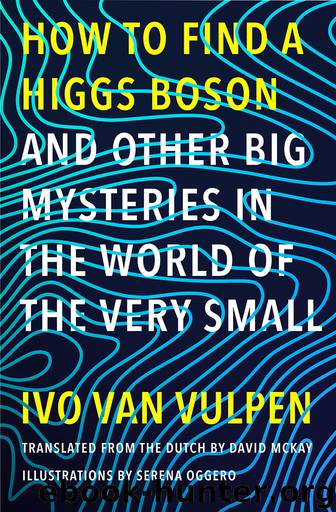How to Find a Higgs Boson by Ivo van Vulpen

Author:Ivo van Vulpen [Vulpen, Ivo Van]
Language: eng
Format: epub
Publisher: Yale University Press
Published: 2019-03-10T16:00:00+00:00
Even so, there were critical voices. Although the quark model explained the measurements perfectly, the question remained: were quarks merely a mathematical trick, or did protons really have a substructure? No one had ever seen a single quark in an experiment. And there was another problem: the particles at the three corners of the figure are each composed of three identical quarks—three quarks of exactly the same type, with exactly the same properties, like mass, spin, and spin direction. Our theory told us that was impossible. Why? Well, Pauli’s exclusion principle, which we ran into in an earlier chapter, states that different particles in a system can never have exactly the same properties. That principle explained the structure of electrons in atoms and had become a fundamental requirement in the quantum mechanical description of elementary particles. Three identical particles in a combined state? Unthinkable!
The first problem—namely, showing that a proton really is made of quarks—was solved with the same trick used by Rutherford in 1910: making particles that were much smaller than a proton and bouncing them off the proton to see if we could describe its shape. Was it solid through and through, like a billiard ball? Or did it have an internal structure, like a walnut? More specifically, did it consist of three smaller balls at its core? In 1968 we finally managed to accelerate particles to a high enough energy to make them smaller than the proton itself, so that we could use them as microscopes to look inside the proton. It was immediately clear that the proton does have a hidden substructure.
The solution to the second problem, the more theoretical puzzle of the three identical particles in a composite system, was also simpler than expected. If we wanted to save Pauli’s exclusion principle, we had to find some difference between the three identical-looking quarks. The similar problem of identical-looking electrons had been solved when young scientists in Leiden thought up the previously hidden property of spin. We could solve the quark problem the same way, by concluding that they had some extra property we had missed before, with a different value for each of the three quarks in the larger particles. This new property was named “color” and assigned three values: red, green, and blue.
The term “color” may be confusing, because we associate it with a property in our everyday world, but it works the same way as the property of electrical charge, which also has a limited set of values (0, ±1e, ±2e, . . . ) or spin, which has two possible values (±1/2ℏ). In short, we discovered a property of quarks we hadn’t known about, but that made them satisfy Pauli’s exclusion principle. Each quark came in three versions, and the three quarks in a composite particle were therefore not identical but each had a unique color. So quarks existed and were the new front line in the search for the elementary building blocks of nature.
Three other quarks were eventually found alongside the up, down, and strange quarks.
Download
This site does not store any files on its server. We only index and link to content provided by other sites. Please contact the content providers to delete copyright contents if any and email us, we'll remove relevant links or contents immediately.
| Electron Microscopes & Microscopy | Experiments & Projects |
| Measurement | Microscopes & Microsocopy |
| Scientific Instruments | Telescopes |
| Time | Methodology & Statistics |
Hands-On Genetic Algorithms with Python by Eyal Wirsansky (2020) by Unknown(4087)
Thing Explainer by Randall Munroe(3912)
The Elements by Theodore Gray(3028)
The Meaning of it All by Richard Feynman(2320)
Make by Mike Westerfield(2306)
Every Tool's a Hammer by Adam Savage(1915)
Science Experiments You Can Eat by Vicki Cobb(1856)
The Perfectionists by Sara Shepard(1806)
Martin Gardner's Science Magic by Martin Gardner(1709)
Raspberry Pi Electronics Projects for the Evil Genius (Tab) by Norris Donald & Norris Donald(1690)
Elephants on Acid by Boese Alex(1580)
Elephants on Acid: And Other Bizarre Experiments by Alex Boese(1577)
The Perfectionists by Simon Winchester(1573)
Handbook of Modern Sensors by Jacob Fraden(1560)
Synchrotron Light Sources and Free-Electron Lasers by Eberhard J. Jaeschke Shaukat Khan Jochen R. Schneider & Jerome B. Hastings(1540)
Tesla by Carlson W. Bernard(1503)
The Science of Food by Marty Jopson(1463)
125 Physics Projects for the Evil Genius by Silver Jerry(1431)
The Meaning Of It All by Richard P. Feynman(1431)
